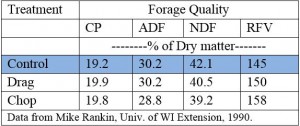 |
 |
What should I do with alfalfa residue from last fall on fields?
Dan Undersander
University of Wisconsin
Many growers leave fall growth of alfalfa in the field rather than taking a late fall cutting to enhance winter survival and rate of spring greenup. The stems from this fall growth remain in the spring and some farmers wonder if they should remove it to increase forage quality. The short answer is no – the cost of removing the residue is greater than the value received.
When residue is left in the fall, most of it goes away over winter (leaf loss, grazing by deer, rabbits, mice, etc). In fact, when we measured alfalfa loss over winter we found that, with as much as 4,000 DM lbs/acre forage in the late fall, less than 600 lbs/a remained in the spring harvested forage. This amount of residue in spring forage is visible and looks bad but is a small amount compared to the 2 t/a or greater first cutting yield.
In one trial, residue was either knocked down in April by one of two methods or left standing for first cutting (control). The two methods of knocking down the residue were either by pulling a spike-tooth drag across the field with the teeth in the “up” position to avoid damaging alfalfa crowns or by flail chopping with chopper set 2-inches above soil surface and chopped material blown back onto the field. The three treatments (two residue knockdown plus control) were applied at two different locations in the field and then forage quality of the alfalfa was measured when alfalfa was harvested on May 25 at the mid-bud stage.
The effect of residue removal on first cutting forage quality (means of the two locations) is shown in table 1. Forage harvested from the control (with residue) had about 0.6% less protein, 1.5 to 2% more Neutral Detergent Fiber (NDF) and 5 to 8 pts less RFV due to the inclusion of low quality residue from fall. Thus, while some of the residue from fall growth is in the spring harvested forage, the change in forage quality is small and not worth the expense in labor, fuel, and wear and tear on equipment to make it economic to do anything with the residue.

Table 1. Effect of early spring chopping or dragging fall aftermath on first cut alfalfa forage quality.
The effects of fall aftermath growth on forage quality is greater when first-cut alfalfa is harvested at early stages of maturity (as in table 1) versus post-flower stages because the same amount of aftermath is present but yield is less from the earlier cutting. At early maturity stages, the dead material (primarily stems) would make up a greater percentage (but still less than 15%) of the total dry matter harvested.
Driving on alfalfa stands in the early spring can cause crown damage if fields are frozen or wet. In many years, weather conditions result in a small time frame to flail chop or drag alfalfa fields. The wheel traffic on alfalfa early in the spring can often cause yield loss which is why fertilizer is usually applied after first cutting when fields are drier.
Thus, while removing fall residue in the spring may result in slightly higher forage quality, the economics of chopping residue or driving a spike-tooth drag across alfalfa fields in the spring are questionable. Any increase in forage quality must pay for the field operation. Flail chopping will be a more costly alternative than dragging. Value for knocking down or removing fall residue may be present for marketed hay (where appearance is important) but is not likely to be economic for farmers growing and feeding their own forage.



